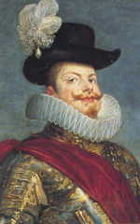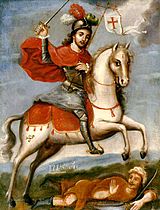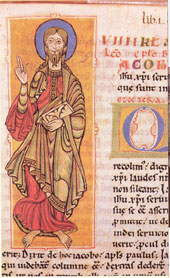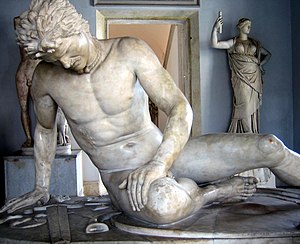Origins

Overview of the
Hallstatt and
La Tène cultures.
The core Hallstatt territory (HaC, 800 BC) is shown in solid yellow, the eventual area of Hallstatt influence (by 500 BC, HaD) in light yellow. The core territory of the La Tène culture (450 BC) is shown in solid green, the eventual area of La Tène influence (by 50 BC) in light green. The territories of some major
Celtic tribes of the late La Tène period are labeled.
The Celtic languages form a branch of the larger Indo-European family. By the time speakers of Celtic languages enter history around 400 BC (Brennus's attack on Rome in 387 BC), they were already split into several language groups, and spread over much of Central Europe, the Iberian peninsula, Ireland and Britain.
Some scholars think that the Urnfield culture of northern Germany and the Netherlands represents an origin for the Celts as a distinct cultural branch of the Indo-European family. This culture was preeminent in central Europe during the late Bronze Age, from ca. 1200 BC until 700 BC, itself following the Unetice and Tumulus cultures. The Urnfield period saw a dramatic increase in population in the region, probably due to innovations in technology and agricultural practices. The Greek historian Ephoros of Cyme in Asia Minor, writing in the fourth century BC, believed that the Celts came from the islands off the mouth of the Rhine who were "driven from their homes by the frequency of wars and the violent rising of the sea".
The spread of iron-working led to the development of the Hallstatt culture directly from the Urnfield (c. 700 to 500 BC). Proto-Celtic, the latest common ancestor of all known Celtic languages, is considered by this school of thought to have been spoken at the time of the late Urnfield or early Hallstatt cultures, in the early first millennium BC. The spread of the Celtic languages to Iberia, Ireland and Britain would have occurred during the first half of the 1st millennium BC, the earliest chariot burials in Britain dating to ca. 500 BC. Over the centuries they developed into the separate Celtiberian, Goidelic and Brythonic languages.
The Hallstatt culture was succeeded by the La Tène culture of central Europe, and during the final stages of the Iron Age gradually transformed into the explicitly Celtic culture of early historical times. Celtic river-names are found in great numbers around the upper reaches of the Danube and Rhine, which led many Celtic scholars to place the ethnogenesis of the Celts in this area.
Diodorus Siculus and Strabo both suggest that the Celtic heartland was in southern France. The former says that the Gauls were to the north of the Celts but that the Romans referred to both as Gauls. Before the discoveries at Hallstatt and La Tene, it was generally considered that the Celtic heartland was southern France, see Encyclopedia Britannica for 1813.
Almagro-Gorbea[6] proposed the origins of the Celts could be traced back to the third millennium BC, seeking the initial roots in the Bell Beaker culture, thus offering the wide dispersion of the Celts throughout western Europe, as well as the variability of the different Celtic peoples, and the existence of ancestral traditions an ancient perspective.
Meanwhile, genetics, history, and archaeological researcher and writer Stephen Oppenheimer suggests the Celts were a Mediterranean people first established in what is now southern France by the end of the last glacial maxum, around 11,000BC. From there through further integration with what might have been proto-Basque populations, these people spread outward into Italy, Spain, the British Isles and Germany. Indeed, Celtic origin myths recorded in Medieval Scotland and Ireland suggest a possible beginning in Anatolia and then to Iberia via Egypt. But, in his 2006 book The Origins of the British, revised in 2007, he argued that neither Anglo-Saxons nor Celts had much impact on the genetics of the inhabitants of the British Isles, and that British ancestry mainly traces back to the Palaeolithic Iberian people, now represented by Basques, instead. More recently, it has been noted [7] that the distribution of the gene for lactase persistence apparently originating near the Baltic Sea between 4,800 and 6,000 B.P. indicates a spread from there to both the British Isles and to Iberia later than the original paleolithic population spread.
Linguistic evidence
The
Proto-Celtic language is usually dated to the early
European Iron Age. The earliest records of a Celtic language are the
Lepontic inscriptions of
Cisalpine Gaul, the oldest of which still predate the
La Tène period. Other early inscriptions are
Gaulish, appearing from the early La Tène period in inscriptions in the area of
Massilia, in the Greek alphabet.
Celtiberian inscriptions appear comparatively late, after about 200 BC. Evidence of
Insular Celtic is available only from about AD 400, in the form of
Primitive Irish Ogham inscriptions. Besides epigraphical evidence, an important source of information on early Celtic is
toponymy.
[Gallic Calendar
The Coligny Calendar, which was found in 1897 in Coligny, Ain, was engraved on a bronze tablet, preserved in 73 fragments, that originally was 1.48 m wide and 0.9 m high (Lambert p. 111). Based on the style of lettering and the accompanying objects, it probably dates to the end of the 2nd century.[30] It is written in Latin inscriptional capitals, and is in the Gallic language. The restored tablet contains sixteen vertical columns, with sixty-two months distributed over five years.
The French archaeologist J. Monard speculated that it was recorded by druids wishing to preserve their tradition of timekeeping in a time when the Julian calendar was imposed throughout the Roman Empire. However, the general form of the calendar suggests the public peg calendars (or parapegmata) found throughout the Greek and Roman world.[31]
There were four major festivals in the Gallic Calendar: "Imbolc" on 1 February, possibly linked to the lactation of the ewes and sacred to the Irish Goddess Brigid. "Beltaine" on 1 May, connected to fertility and warmth, possibly linked to the Sun God Belenos. "Lúnasa" on 1 August, connected with the harvest and associated with the God Lugh. And finally "Samhain" on 1 November, possibly the start of the year.[32] Two of these festivals, Beltaine and Lúnasa are shown on the Coligny Calendar by sigils, and it is not too much of a stretch of the imagination to match the first month on the Calendar (Samonios) to Samhain. Imbolc does not seem to be shown at all however.[33]
The Celtic Calendar seems to be based on astronomy
[34] but how any astrology system would have worked is harder to tell. We have to base our knowledge on
Old Irish manuscripts, none of which have been published or fully translated. It seems to have been based on an indigenous Irish symbol system, and not that of any of the more commonly-known astrological systems such as
Western,
Chinese or
Vedic astrology.
Society
To the extent that sources are available, they depict a pre-Christian Celtic social structure based formally on class and kingship. Patron-client relationships similar to those of Roman society are also described by Caesar and others in the Gaul of the first century BC.
In the main, the evidence is of tribes being led by kings, although some argue that there is evidence of oligarchical republican forms of government eventually emerging in areas in close contact with Rome. Most descriptions of Celtic societies describe them as being divided into three groups: a warrior aristocracy; an intellectual class including professions such as druid, poet, and jurist; and everyone else. There are instances recorded where women participated both in warfare and in kingship, although they were in the minority in these areas. In historical times, the offices of high and low kings in Ireland and Scotland were filled by election under the system of tanistry, which eventually came into conflict with the feudal principle of primogeniture where the succession goes to the first born son.
Little is known of family structure among the Celts. Patterns of settlement varied from decentralised to the urban. The popular stereotype of non-urbanised societies settled in hillforts and duns, drawn from Britain and Ireland (there are over 2000 hill forts known in Britain)[36] contrasts with the urban settlements present in the core Hallstatt and La Tene areas, with the many significant oppida of Gaul late in the first millennium BC, and with the towns of Gallia Cisalpina.
Slavery as practiced by the Celts was very likely similar to the better documented practice in ancient Greece and Rome.[37] Slaves were acquired from war, raids, penal and debt servitude.[37] Slavery was hereditary, although manumission was possible. The Old Irish word for slave, cacht, and the Welsh term caeth are likely derived from the Latin captus, captive, suggesting that slave trade was an early venue of contact between Latin and Celtic societies.[37] In the Middle Ages, slavery was especially prevalent in the Celtic countries.[38] Manumissions were discouraged by law and the word for "female slave", cumal, was used as a general unit of value in Ireland.[39]
There is archaeological evidence to suggest that the pre-Roman Celtic societies were linked to the network of overland trade routes that spanned Eurasia. Large prehistoric trackways crossing bogs in Ireland and Germany have been found by archaeologists. They are believed to have been created for wheeled transport as part of an extensive roadway system that facilitated trade, because of their substantial nature.[40] The territory held by the Celts contained tin, lead, iron, silver and gold.[41] Celtic smiths and metalworkers created weapons and jewelry for international trade, particularly with the Romans.
The myth that the Celtic monetary system consisted of wholly barter is a common one, but is in part false. The monetary system was complex and is still not understood (much like the late Roman coinages), and due to the absence of large numbers of these coin items it is assumed that "proto-money" was used, which is the collective name given to the bronze items made from the early La Tene period onwards, and were often in the shape of axeheads, rings and bells. Due to the large number of these present in some burials it is thought they had a relatively high monetary value, and could be used for "day to day" purchases. Low value coinages of potin, consisting mainly of tin, but also were minted in gold, silver and bronze of higher value, suitable for use in trade, were minted in most Celtic areas of the continent, and in South-East Britain prior to the Roman conquest of these areas. Gold coinage was much more common than silver coinage, despite being worth substantially more, as there were around 100 mines in Southern Britain and Central France, but silver was more rarely mined, partly due to the comparative sparcity of mines and the amount of effort needed for extraction compared to the profit gained. Silver and bronze coinage became more common with the rise of the Roman civilisation, due to trade with them, and this coincided with a major increase in gold production in the Celtic world to meet the Roman demand, made by the high value romans put on it. The large number of gold mines in France is thought to be a major reason why Caesar invaded.
There are only very limited records from pre-Christian times written in Celtic languages. These are mostly inscriptions in the Roman, and sometimes Greek, alphabets. The Ogham script was mostly used in early Christian times in Ireland and Scotland (but also in Wales and England), and was only used for ceremonial purposes such as inscriptions on gravestones. The available evidence is of a strong oral tradition, such as that preserved by bards in Ireland, and eventually recorded by monasteries. The oldest recorded rhyming poetry in the world is of Irish origin and is a transcription of a much older epic poem, leading some scholars to claim that the Celts invented Rhyme. They were highly skilled in visual arts and Celtic art produced a great deal of intricate and beautiful metalwork, examples of which have been preserved by their distinctive burial rites.
In some regards the Atlantic Celts were conservative, for example they still used chariots in combat long after they had been reduced to ceremonial roles by the Greeks and Romans, though when faced with the Romans in Britain, their chariot tactics defeated the invasion attempted by Julius Caesar.
According to Diodorus Siculus:
Polytheism
The Celts had an indigenous polytheistic religion and culture.[66]
Many Celtic gods are known from texts and inscriptions from the Roman period, such as Aquae Sulis, while others have been inferred from place names such as Lugdunum (stronghold of Lug). Rites and sacrifices were carried out by priests, known as Druids. The Celts did not see their gods as having a human shape until late in the Iron Age. Celtic shrines were situated in remote areas such as hilltops, groves, and lakes.
Celtic religious patterns were regionally variable; however, some patterns of deity forms, and ways of worshiping these deities, appear over a wide geographical and temporal range. The Celts worshipped both gods and goddesses. In general, the gods were deities of particular skills, such as the many-skilled Lugh and Dagda, and the goddesses were associated with natural features, particularly rivers (such as Boann, goddess of the River Boyne). This was not universal, however, as goddesses such as Brighid and The Morrígan were associated with both natural features (holy wells and the River Unius) and skills such as blacksmithing and healing.[67]
Triplicity is a common theme in Celtic cosmology, and a number of deities were seen as threefold.[68]
The Celts had literally hundreds of deities, some unknown outside of a single family or tribe, while others were popular enough to have a following that crossed boundaries of language and culture. For instance, the Irish god Lugh, associated with storms, lightning, and culture, is seen in similar forms as Lugos in Gaul and Lleu in Wales. Similar patterns are also seen with the continental Celtic horse goddess Epona, and what may well be her Irish and Welsh counterparts, Macha and Rhiannon, respectively.[69]
Roman reports of the druids mention ceremonies being held in sacred groves. La Tène Celts built temples of varying size and shape, though they also maintained shrines at sacred trees and votive pools.[66]
Druids fulfilled a variety of roles in
Celtic religion, as priests and religious officiants, but also as judges, sacrificers, teachers, and lore-keepers. Druids organized and ran the religious ceremonies, and they memorized and taught the
calendar. Other classes of druids performed ceremonial sacrifices of crops and
animals for the perceived benefit of the community.
Celtic Christianity
While the regions under Roman rule adopted Christianity along with the rest of the Roman empire, unconquered areas of Ireland and Scotland moved from Celtic polytheism to Celtic Christianity in the fifth century AD. Ireland was converted under missionaries from Britain, such as Patrick. Later missionaries from Ireland were a major source of missionary work in Scotland, Saxon parts of Britain, and central Europe (see Hiberno-Scottish mission). The development of Christianity in Ireland and Britain brought an early medieval renaissance of Celtic art between 390 and 1200 AD[citation needed], developing many of the styles now thought of as typically Celtic, and found throughout much of Ireland and Britain, including the northeast and far north of Scotland, Orkney and Shetland. This Celtic renaissance was ended by the Norman Conquest of Ireland in the late 12th century.[citation needed] Notable works produced during this period include the Book of Kells and the Ardagh Chalice. Antiquarian interest from the 17th century led to the term 'Celt' being extended, and rising nationalism brought Celtic revivals from the 19th century.














